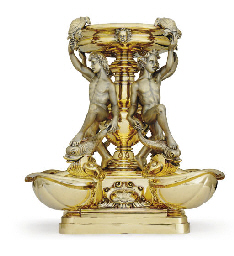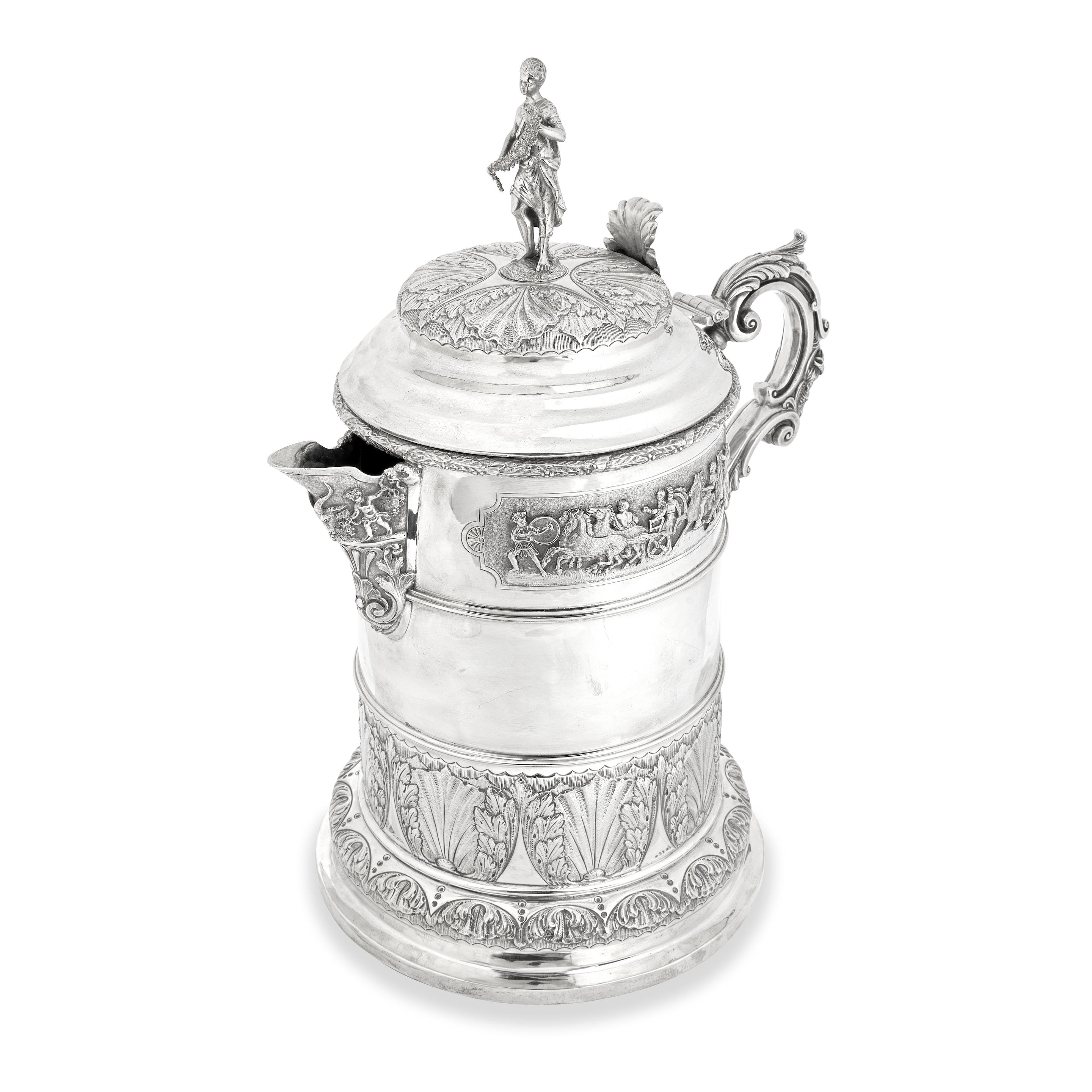A monumental Victorian silver and parcel-gilt double-handled cup and coverCharles Frederick Hancock, London 1866, designed and modelled by Henry Hugh Armstead (1828-1905) Tapering urn form, polished gilt highlights to the whole, the vase-shaped flaring neck embossed with symmetrical arabesques, repoussé ovals, diamonds and hearts against a matt and burnished ground, a shaped scroll and foliate upper rim, the pull-off double-knop circular cover topped by a baluster finial, the two handles formed by a pair of cast female Winged Victory, one either side draped in diaphanous garb, a circular laurel wreath in each hand, arms outstretched, both elegantly balanced on the head of a roaring mythical beast, to the main a three dimensional English Civil War diorama with Roundheads and Cavaliers on horseback, arms and flags aloft, and on the reverse an engraved armorial for SIR DAVID BAXTER (1793-1872), First Baronet of Kilmaron, within applied fleur-de-lis and foliage, a gilded double banded girdle to the lower body, repeating arabesques tapering to a shaped octagonal mount, the knop beneath joined to a spreading circular base adorned with cast mythical sea creatures and scrolling leaves, a domed heart-shaped cartouche either side inscribed with initials and set within an openwork shield, the stepped foot with zig-zag motifs and gilded rim, height 65cm, diameter approx 28cm, weight 228oz.FootnotesThe design and manufacture of grand presentation silver reached the peak of its popularity in the mid-19th century. At the top end of the silver market, sculptural trophies and testimonials dominated this period; trophies awarded for competitive achievements such as horse racing, and testimonials presented to worthy individuals. 'These silver sculptures, bulky, glittering and proud, celebrated the achievements of the Victorian industrialist, soldier and sportsman and demonstrated the virtuoso skills and techniques of the contemporary silversmith' (Patterson, p.59). The subject matter chosen for these pieces was always on an epic scale, often figural compositions featuring dramatic mythological tales or key historical moments. Heroes from history were frequently staged in mounted combat against man or beast, often within a battle scene or historical diorama. Whatever the scene portrayed, each element was meticulously designed and modelled, with every minuscule detail intricately cast and hand-chased for absolute realism. These trophies were a vehicle to not only showcase silver as a national art form, but also to symbolise and represent Britain's place as a trailblazing manufacturing nation in the industrial age – art and industry combined to spectacular effect. The most prominent silver manufacturers at the time, such as Hancock's, Garrard's, Elkington and Hunt & Roskell, used the International Exhibitions to great effect, ladening their stands with massive exhibition trophies and testimonials in order to reach a far wider clientele. The World Fairs were great advertising vehicles, akin to the Instagram of the day, allowing a worldwide audience of thousands to view their work – each company trying to outshine the other, hoping to win prestigious commissions. What is fortuitous when researching presentation silver is the fact that the press loved them, and by searching newspaper archives such as the 'Illustrated London News' and the 'Art Journal' amongst many others, it is possible to discover illustrations and potentially the dates of these pieces. However, what needs to be noted is that these exhibition silver pieces frequently stayed in the goldsmith's showroom for years and were moved from one exhibition to another. Sometimes their history can be traced through inscriptions or the arms of later owners, who frequently bought them years after the date of manufacture. As such, exhibition dates and manufacturing dates in terms of hallmarks often do not tally; in other words when you see it illustrated in a paper with the date of publication, it d
A monumental Victorian silver and parcel-gilt double-handled cup and coverCharles Frederick Hancock, London 1866, designed and modelled by Henry Hugh Armstead (1828-1905) Tapering urn form, polished gilt highlights to the whole, the vase-shaped flaring neck embossed with symmetrical arabesques, repoussé ovals, diamonds and hearts against a matt and burnished ground, a shaped scroll and foliate upper rim, the pull-off double-knop circular cover topped by a baluster finial, the two handles formed by a pair of cast female Winged Victory, one either side draped in diaphanous garb, a circular laurel wreath in each hand, arms outstretched, both elegantly balanced on the head of a roaring mythical beast, to the main a three dimensional English Civil War diorama with Roundheads and Cavaliers on horseback, arms and flags aloft, and on the reverse an engraved armorial for SIR DAVID BAXTER (1793-1872), First Baronet of Kilmaron, within applied fleur-de-lis and foliage, a gilded double banded girdle to the lower body, repeating arabesques tapering to a shaped octagonal mount, the knop beneath joined to a spreading circular base adorned with cast mythical sea creatures and scrolling leaves, a domed heart-shaped cartouche either side inscribed with initials and set within an openwork shield, the stepped foot with zig-zag motifs and gilded rim, height 65cm, diameter approx 28cm, weight 228oz.FootnotesThe design and manufacture of grand presentation silver reached the peak of its popularity in the mid-19th century. At the top end of the silver market, sculptural trophies and testimonials dominated this period; trophies awarded for competitive achievements such as horse racing, and testimonials presented to worthy individuals. 'These silver sculptures, bulky, glittering and proud, celebrated the achievements of the Victorian industrialist, soldier and sportsman and demonstrated the virtuoso skills and techniques of the contemporary silversmith' (Patterson, p.59). The subject matter chosen for these pieces was always on an epic scale, often figural compositions featuring dramatic mythological tales or key historical moments. Heroes from history were frequently staged in mounted combat against man or beast, often within a battle scene or historical diorama. Whatever the scene portrayed, each element was meticulously designed and modelled, with every minuscule detail intricately cast and hand-chased for absolute realism. These trophies were a vehicle to not only showcase silver as a national art form, but also to symbolise and represent Britain's place as a trailblazing manufacturing nation in the industrial age – art and industry combined to spectacular effect. The most prominent silver manufacturers at the time, such as Hancock's, Garrard's, Elkington and Hunt & Roskell, used the International Exhibitions to great effect, ladening their stands with massive exhibition trophies and testimonials in order to reach a far wider clientele. The World Fairs were great advertising vehicles, akin to the Instagram of the day, allowing a worldwide audience of thousands to view their work – each company trying to outshine the other, hoping to win prestigious commissions. What is fortuitous when researching presentation silver is the fact that the press loved them, and by searching newspaper archives such as the 'Illustrated London News' and the 'Art Journal' amongst many others, it is possible to discover illustrations and potentially the dates of these pieces. However, what needs to be noted is that these exhibition silver pieces frequently stayed in the goldsmith's showroom for years and were moved from one exhibition to another. Sometimes their history can be traced through inscriptions or the arms of later owners, who frequently bought them years after the date of manufacture. As such, exhibition dates and manufacturing dates in terms of hallmarks often do not tally; in other words when you see it illustrated in a paper with the date of publication, it d










.jpg?w=400)



Try LotSearch and its premium features for 7 days - without any costs!
Be notified automatically about new items in upcoming auctions.
Create an alert